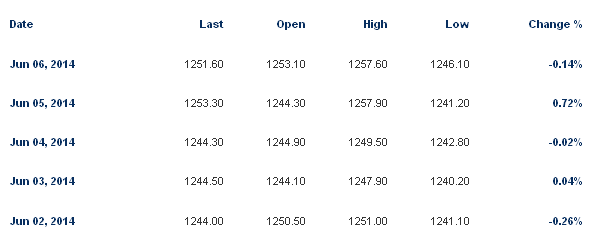Gold gave back a bit of Thursday’s gains to close the week at 1251.60 after touching a weekly high of 1257.90. Gold ended the week up 0.5% after prices got a boost from the ECB’s decision Thursday to cut its main lending rate. The central bank also dropped the rate on bank deposits to minus 0.1%, thereby charging banks for keeping their money with the ECB.
Gold prices tend to rise during periods of accommodative monetary policy, as investors who worry that such programs could erode the value of their wealth or raise inflation often buy the precious metal as a hedge. However, gold can struggle to attract investors during periods of a more hawkish monetary stance.

On Friday, gold prices fell after the Labor Department said the U.S. economy added 217,000 new jobs in May. This bested economists’ forecasts of a 210,000 increase.
The stronger employment report pointed to continued economic recovery and reaffirmed investor expectations that the Federal Reserve would curtail its stimulus program by the end of this year, clearing the way for higher interest rates.
“The Fed is not going to stop winding down stimulus; they’ve got employment picking up, and the stock market is going up,” said Ira Epstein, director of the Ira Epstein division with the Linn Group.
But, gold prices swung between gains and losses for some time before turning lower, a sign that the employment report wasn’t robust enough to dictate direction to the market, said Frank McGhee, a head precious-metals dealer with Integrated Brokerage Services in Chicago.
Historical: From 2011 to present
Highest: 1911.60 on Sep 06, 2011
Average: 1633.45 over this period
Lowest: 1180.35 on Jun 28, 2013

